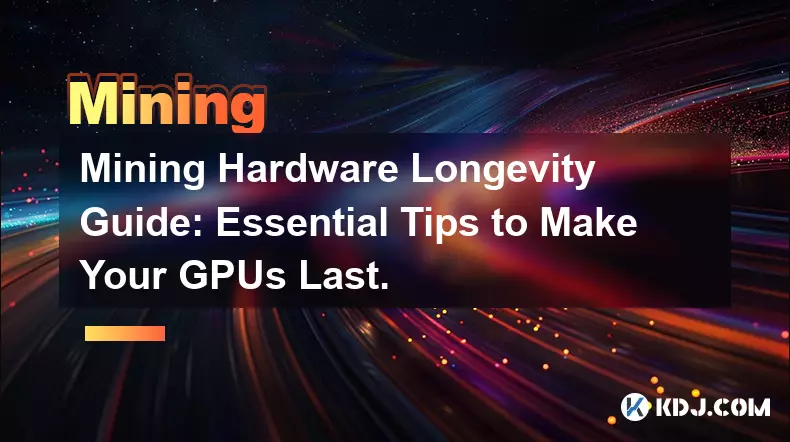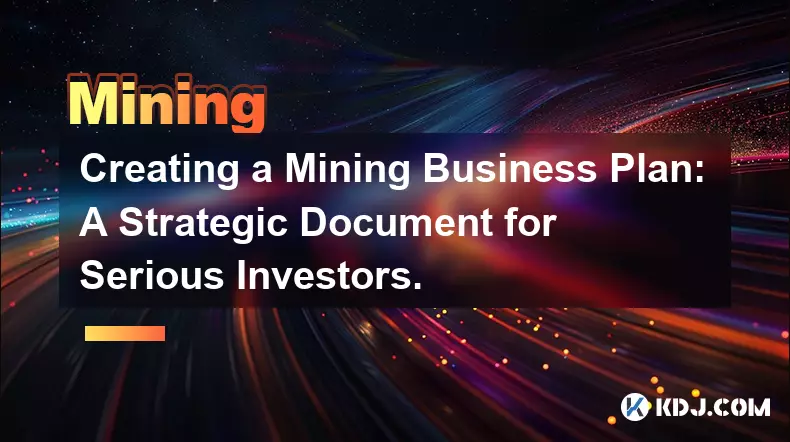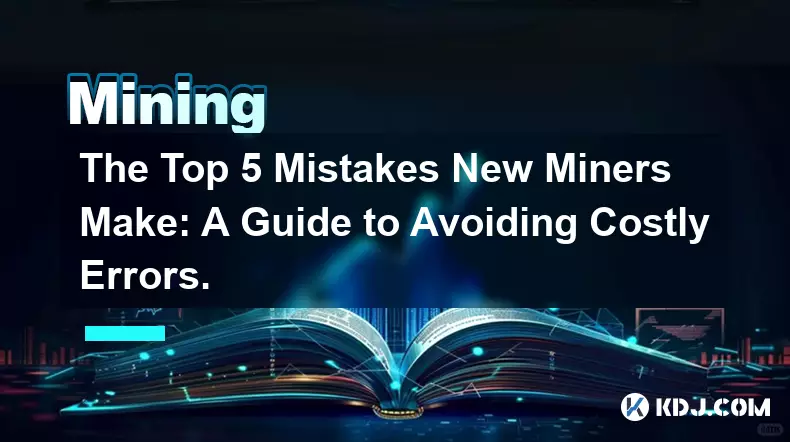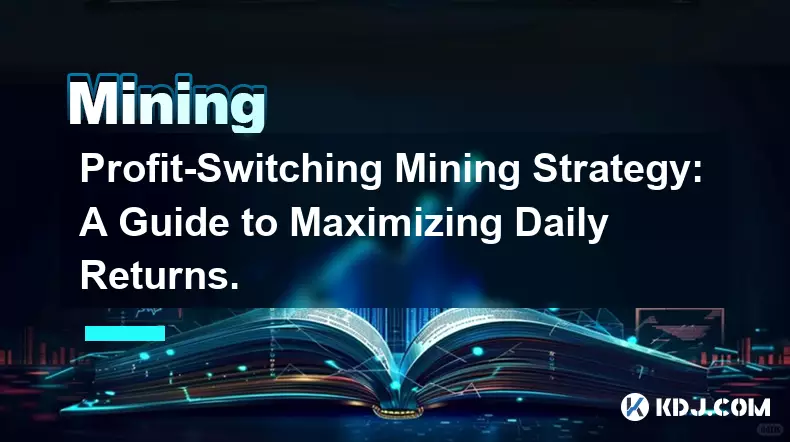-
 bitcoin
bitcoin $99177.955738 USD
-7.32% -
 ethereum
ethereum $3187.183061 USD
-12.38% -
 tether
tether $0.999809 USD
0.00% -
 xrp
xrp $2.117933 USD
-9.42% -
 bnb
bnb $906.710033 USD
-9.17% -
 solana
solana $149.367737 USD
-10.74% -
 usd-coin
usd-coin $0.999816 USD
0.01% -
 tron
tron $0.281498 USD
-0.38% -
 dogecoin
dogecoin $0.156292 USD
-8.00% -
 cardano
cardano $0.500744 USD
-10.19% -
 hyperliquid
hyperliquid $38.087358 USD
-4.58% -
 chainlink
chainlink $14.097831 USD
-8.54% -
 bitcoin-cash
bitcoin-cash $463.329916 USD
-9.22% -
 ethena-usde
ethena-usde $0.999078 USD
-0.01% -
 unus-sed-leo
unus-sed-leo $9.475862 USD
-0.79%
How to build a crypto mining rig step-by-step?
Choose high-performance GPUs like the RTX 3090 or RX 6800 XT, pair with a multi-GPU motherboard, reliable PSU, and efficient cooling for optimal mining rig performance.
Oct 26, 2025 at 08:18 am

Choosing the Right Hardware Components
1. Select a high-performance graphics processing unit (GPU) that offers strong hash rates for your chosen cryptocurrency. Models like the NVIDIA RTX 3090 or AMD RX 6800 XT are popular due to their efficiency and power in handling complex mining algorithms.
2. Choose a motherboard that supports multiple GPUs, such as the ASRock H110 Pro BTC+ or MSI B450 Tomahawk, which allow expansion slots necessary for multi-GPU configurations.
3. Use a reliable central processing unit (CPU), though mining primarily relies on GPU power. A basic but stable CPU like the Intel Celeron G3900 is sufficient for system operations.
4. Install adequate RAM—8GB of DDR4 memory ensures smooth multitasking between mining software and background processes.
5. Pick a power supply unit (PSU) with enough wattage to support all components. For rigs with six GPUs, a 1200W to 1600W 80 Plus Gold PSU is recommended to maintain stability and prevent overloads.
Assembling the Mining Rig
1. Set up the motherboard on a non-conductive surface or inside a dedicated mining frame. Secure it properly to avoid short circuits.
2. Insert the CPU into its socket and attach the cooling fan. Apply thermal paste if not pre-applied on the heatsink.
3. Install the RAM sticks into their designated slots, pressing down firmly until they click into place.
4. Mount each GPU using PCIe riser cables. These extenders connect the GPUs to the motherboard and allow better spacing and airflow.
5. Connect all power cables from the PSU to the motherboard, CPU, and each GPU. Double-check connections to ensure no loose wires that could cause interruptions during operation.
Proper ventilation and cable management significantly reduce overheating risks and improve long-term rig performance.
Installing Software and Configuring Mining Operations
1. Install a lightweight operating system optimized for mining, such as HiveOS or SimpleMining OS. These systems boot from USB drives and manage hardware efficiently with minimal resource usage.
2. Once the OS is running, configure network settings to establish an internet connection. This step is crucial for communicating with mining pools.
3. Choose a mining pool based on your target cryptocurrency. For Ethereum, options include Ethermine or F2Pool; for Ravencoin, consider TeamRedMiner or Nanopool.
4. Download and install the appropriate mining software—T-Rex Miner for NVIDIA cards or PhoenixMiner for AMD setups—and input your wallet address and pool server details.
5. Adjust overclocking settings through the BIOS or mining software interface to optimize power consumption versus hash rate. Monitor temperatures closely to avoid damaging hardware.
Monitoring and Maintaining Performance
1. Regularly check dashboard statistics provided by your mining OS to track uptime, rejected shares, and temperature levels across all GPUs.
2. Clean dust buildup from fans and heat sinks every two weeks to maintain optimal cooling. Use compressed air to avoid physical damage.
3. Update firmware and mining software periodically to benefit from bug fixes, security patches, and improved efficiency.
4. Rotate GPUs occasionally to balance wear and tear, especially in large-scale operations where consistent output is critical.
5. Keep spare parts like riser cables and PSUs on hand to minimize downtime in case of sudden failures.
Frequently Asked Questions
What is the best cryptocurrency to mine with a GPU rig?Ethereum Classic, Ravencoin, and Ergo are currently among the most profitable options for GPU miners due to their resistance to ASIC dominance and active development communities.
How much electricity does a typical mining rig consume?A six-GPU rig can draw between 800W to 1200W under full load. Actual consumption depends on GPU models, overclocking settings, and ambient temperature.
Can I use consumer-grade GPUs for professional mining operations?Yes, many operators use retail GPUs, though continuous 24/7 operation may shorten lifespan. Proper cooling and undervolting can mitigate some risks.
Is it necessary to use a separate computer to control the mining rig?No. Modern mining OS platforms run independently on the rig itself and offer web-based dashboards accessible from any device on the same network.
Disclaimer:info@kdj.com
The information provided is not trading advice. kdj.com does not assume any responsibility for any investments made based on the information provided in this article. Cryptocurrencies are highly volatile and it is highly recommended that you invest with caution after thorough research!
If you believe that the content used on this website infringes your copyright, please contact us immediately (info@kdj.com) and we will delete it promptly.
- Nano (XNO) Ignites: Volume Spike and Price Jump Signals Comeback?
- 2025-11-05 14:50:11
- Bitcoin's Bear Signal: Is a Collapse Incoming?
- 2025-11-05 14:40:15
- Nick Szabo, Bitcoin Future, and BTC: Navigating the Crypto Landscape in 2025
- 2025-11-05 14:50:01
- Bitcoin's Wild Ride: Saylor, Kiyosaki, and the Quest for $200K
- 2025-11-05 10:50:13
- Culex, Cardano, and Aster: A Crypto Cocktail of Mosquitoes, Dips, and CZ Fuel
- 2025-11-05 11:00:17
- Crypto Presales, Coin Growth, and Established Coins: Navigating the 2025 Buzz
- 2025-11-05 11:00:17
Related knowledge

Mining Hardware Longevity Guide: Essential Tips to Make Your GPUs Last.
Nov 01,2025 at 04:00pm
Mining Hardware Longevity Guide: Essential Tips to Make Your GPUs LastAs cryptocurrency mining continues to attract both hobbyists and professionals, ...

Creating a Mining Business Plan: A Strategic Document for Serious Investors.
Nov 04,2025 at 08:54pm
Defining the Core Objectives of a Cryptocurrency Mining Venture1. Establishing a clear mission for the mining operation ensures alignment with investo...

The Top 5 Mistakes New Miners Make: A Guide to Avoiding Costly Errors.
Nov 01,2025 at 10:18am
The Top 5 Mistakes New Miners Make: A Guide to Avoiding Costly Errors Entering the world of cryptocurrency mining can be both exciting and overwhelmin...

The Miner's Guide to Market Cycles: When to Hold and When to Sell.
Nov 03,2025 at 07:55pm
The Miner's Guide to Market Cycles: When to Hold and When to Sell Bitcoin mining has evolved from a hobbyist pursuit into a highly competitive, capita...

Profit-Switching Mining Strategy: A Guide to Maximizing Daily Returns.
Nov 03,2025 at 11:55am
Understanding Profit-Switching in Cryptocurrency Mining1. Profit-switching is a dynamic mining strategy that automatically redirects computational pow...

Setting Up Mining Alerts: A Guide to Monitoring Your Rigs 24/7.
Nov 03,2025 at 02:54pm
Why Continuous Monitoring Is Crucial in Cryptocurrency Mining1. Cryptocurrency mining operations rely heavily on hardware stability and network connec...

Mining Hardware Longevity Guide: Essential Tips to Make Your GPUs Last.
Nov 01,2025 at 04:00pm
Mining Hardware Longevity Guide: Essential Tips to Make Your GPUs LastAs cryptocurrency mining continues to attract both hobbyists and professionals, ...

Creating a Mining Business Plan: A Strategic Document for Serious Investors.
Nov 04,2025 at 08:54pm
Defining the Core Objectives of a Cryptocurrency Mining Venture1. Establishing a clear mission for the mining operation ensures alignment with investo...

The Top 5 Mistakes New Miners Make: A Guide to Avoiding Costly Errors.
Nov 01,2025 at 10:18am
The Top 5 Mistakes New Miners Make: A Guide to Avoiding Costly Errors Entering the world of cryptocurrency mining can be both exciting and overwhelmin...

The Miner's Guide to Market Cycles: When to Hold and When to Sell.
Nov 03,2025 at 07:55pm
The Miner's Guide to Market Cycles: When to Hold and When to Sell Bitcoin mining has evolved from a hobbyist pursuit into a highly competitive, capita...

Profit-Switching Mining Strategy: A Guide to Maximizing Daily Returns.
Nov 03,2025 at 11:55am
Understanding Profit-Switching in Cryptocurrency Mining1. Profit-switching is a dynamic mining strategy that automatically redirects computational pow...

Setting Up Mining Alerts: A Guide to Monitoring Your Rigs 24/7.
Nov 03,2025 at 02:54pm
Why Continuous Monitoring Is Crucial in Cryptocurrency Mining1. Cryptocurrency mining operations rely heavily on hardware stability and network connec...
See all articles










































































